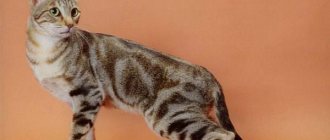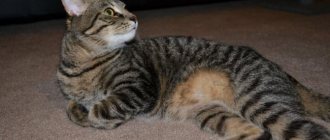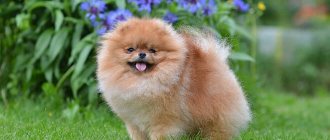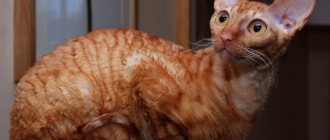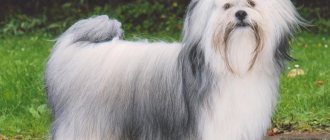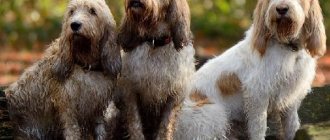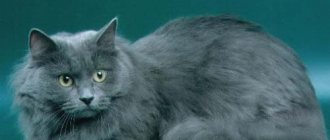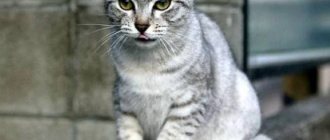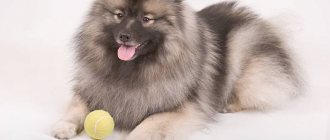Almost all lovers of such pets know the color of color point cats, thanks to the Siamese and Thai breeds. That is why it is quite often confused. But these are not all types of cats that have such an attractive color of their fur. In some distant countries this color may also be called Himalayan. Cats of these breeds are often affectionate and cannot be alone.
Color Description
If translated from English, “color” means color, and “point” means a point. Points are small dark spots located on the face, tail, paws and ears.
The usual color of a cat is solid. The pigment is evenly distributed throughout the animal’s fur and body. Therefore, you can see the uniform color of the pet.
For a color point cat, everything is completely different. Their DNA contains the cs gene, thanks to which the pigment enters only the peripheral parts of the body, that is, the cold ones. They are located at a relative distance from the warm ones. Such areas are the ears, tail, paws and muzzle.
In other parts of the body, where the temperature is relatively higher, the pigment is not able to manifest itself actively. Scientifically this is called acromelanism .
As a result, the pet’s body is painted a lighter color than the rest of the body. The overall color tone remains uniform, but only changes in its saturation and intensity. The more pronounced the border between light and dark coats is, the higher the value of such a cat for exhibition work.
Dark pigmentation can be more than just brown. There are also these colors:
- Black.
- Lilac.
- Smoky.
- Reddish.
- Blue.
Based on this, individual varieties are distinguished, for example, seal point, red point, blue point, etc. Certain breeds can combine several shades at once.
Solid (solid)
Monochrome is considered a classic color scheme. The coat has a uniform toning of the same shade. Since British cats took part in the development of the Scottish Fold breed, the fur coat often acquired a blue or gray color. Moreover, the animals had amber pupils of their eyes.
Blue solid
Various combinations of dominant and recessive genes have led to the emergence of other solid color options:
- ebony (black);
- cinnamon (milk chocolate);
- brown (chocolate);
- faun (deer);
- red (red);
- peach (cream);
- lilac (pale gray);
- white.
In the photo there is a black Scottish fold cat (ebony)
Eye color often directly depends on the color of the coat. White folds have predominantly blue or multi-colored pupils. Lilac and black Scots typically have bright yellow or copper-colored eyes. The amber look is characteristic of chocolate-colored Scottish dogs.
Features of color
The color point cat breed is no longer some kind of exotic. Every year such pets are becoming increasingly popular. But they still have certain features:
- Color point kittens are always born only in light shades. Only after a few days do the first pigment spots begin to appear on the paws, tail, and then on the face. This is due to the fact that during intrauterine development the kittens were exposed to constant warm temperatures. After birth and exposure to a colder environment, the coloring pigment begins to activate, which entails darkening of certain areas of the body.
- The appearance of a point kitten can only be guaranteed if both of its parents also have a pigmented color. But sometimes there are exceptions. One or even both parents can have a solid coat, but be carriers of the cs gene, which is responsible for darkening the peripheral areas of the body. In this case, some kittens will turn out to be pointing.
- The intensity of the color difference depends on the temperature in which the animal is located. The lower it is, the darker and richer the pigment areas will be.
- The cs gene is directly related to the color of the pet's eyes, which must be blue. In this case, the breed does not matter. The brighter and more saturated the color, the better the color of the animal appears.
It must be remembered that cats kept in cool conditions may completely lose their unique color. The ideal temperature for such breeds is from +25 degrees Celsius.
How to choose a kitten
It is very difficult to determine the color of a Siberian color point. A kitten that is completely white from birth, living in different conditions, may have a different final color. This is due to a temperature-sensitive gene. A cat reaches its final formation by the age of four to five years, which makes it difficult to predict the animal’s show class (exhibition class).
When deciding to get a Siberian Color Point, you should decide on the purpose: breeding, exhibitions or a pet. But, regardless of it, it is better to buy a kitten in special nurseries that breed the breed. It is not recommended to take a kitten from its mother before 2-3 months of age. Upon reaching this age, kittens acquire all the necessary skills and become more independent.
The price of a kitten from breeders is from 20,000 rubles and above. You can find out the cost in Moscow and St. Petersburg by following the links below to 8 popular nurseries.
Breeding and show class animals are difficult to identify at a young age. It’s better not to rush and turn to experienced felinologists. The future winner will have to be raised with patience and following the strict recommendations of the breeder. The kitten must learn to “show itself”, get used to examinations by experts and transportation in transport.
Breeders recommend choosing a pet class pet not from photographs, but directly from the nursery. Often, having chosen a kitten by color, future owners do not find a common language with this particular representative of the breed, but leave with other, no less worthy representatives of the breed.
When choosing a companion, it is necessary to evaluate in what conditions and atmosphere the animals are in the nursery. You can try to find contact with the parents of the future pet; it is possible that the character was inherited. It is better to pick up a kitten from the nursery after full vaccination.
Main breeds
Thai and Siamese cat breeds are precisely those that have the color point pigment initially. This is implied by the standard. But there are other types. In addition to plain coats, they also have point subspecies. These include:
- Persian. This is the first breed that has been successfully turned into a pointing breed, with the exception of the Siamese. The Point Persian was created by mating a Siamese cat with an ordinary Persian cat. But there is also a small minus for the owners - a lot of attention must be paid to the luxurious fur of these pets.
- British colorpoint cats. This is a separate subspecies of ordinary Britons, which was first bred not so long ago. Breeding them is quite a difficult task, so babies of this breed are highly valued.
- Scottish straight. Representatives of this breed have darkened areas that look like a light haze. It was possible to breed by mating the best specimens of the British and Persians. These are very beautiful cats, and they also have a soft and flexible character.
- Neva Masquerade. These are Siberian cats with pigment coloring. They were first bred by St. Petersburg breeders by crossing Siberians and Siamese. The artificially bred breed is extremely beautiful. Its representatives have a rather large body with a very thick coat, which was inherited from their Siberian ancestors. It goes well with the colors of the Siamese, as well as the deep blue eyes.
- This coloring is found in all breeds of sphinxes, for example, Canadian or Peterbalds. They have point coloring on their skin, since the fur is completely or almost completely absent.
This is not the entire list of breeds with this coat color. There are also very rare ones, for example, snowshoe or Burmese. But they are not yet very common in the world.
Scottish Highland Straight
The Scottish Highland Straight is a subspecies of the Scottish cat. It is distinguished by the fact that it has long hair and erect ears. This variety has an unusual color. They brought her out in the 70s. years of the last century, when the British crossed with the Persians. Kittens from these breeds were able to get only the best. They have a very calm and friendly character, as well as a cute appearance. Highland Straights are easy to maintain. There is also a tortoiseshell variety, which also has a point color. Description of the breed:
- Quite long coat that is very easy to comb. Has a relatively dense undercoat.
- The ears are small in size with rounded tips and stand erect.
- The eyes are large and round in shape. Color may vary. He is completely dependent on wool.
- The body is strong, muscular, of medium size. Often these cats have a round shape.
- The toes are quite tightly clenched. The limbs themselves are long.
- The head is round and has a convex skull.
- Average tail length. He is very fluffy and active.
- These cats live from 10 to 20 years.
- The average weight of animals is 3.5 kg, and that of a cat is 5 kg.
- Standard length is 30 cm.
This breed is very flexible. But their main advantage is their tenderness and friendliness. When buying a kitten, you should pay attention to the color, as there should not be white color.
If it is present, then such a pet will not be able to participate in exhibitions.
British Shorthair
There is a well-established opinion that this breed was brought to Great Britain in the first century BC by the Romans. The main advantage at that time was considered to be short and very thick wool. It helped protect cats from excessive moisture, as well as small parasites while hunting rodents. The British breed was very hardy and had good health. They were used as hunters. Only many centuries later they began to be looked at from the point of view of beauty. The first exhibition took place in 1871. Description of the breed:
- The British Shorthair cat has a thick and dense coat. The color may be completely different.
- The eyes are large and round in shape. Very often a red tint appears.
- The ears are small and straight, set low.
- The body is of medium size. Cats are usually strong and slender.
- The legs are straight and short.
- Massive round head.
- The neck is powerful and thick.
- The tail is fleshy. Has a rounded end.
- The standard weight for a female is 4 kg, for a male - 6 kg.
- These cats usually live 10-15 years.
The British breed can only be long-haired or short-haired.
A long coat is standard for this species. The short one appeared thanks to the mating of a Briton and a Persian. Many experts argue that the differences are only noticeable in the length of the coat. Although sometimes changes in the chin may also appear.
Compared to the Scots, the British are distinguished by their independence. They may very often do things contrary to instructions. This breed easily tolerates loneliness, but still has a kind and affectionate disposition. Quite often, the British are wary of strangers and do not allow them to touch them.
Scottish Straight Standard
The Scottish Straight cat became an independent breed from the Scottish Fold breed, and was officially recognized by the International Cat Fancier Association (CFA) in 2004.
Scottish cats come in long-haired and short-haired varieties, and come in a variety of colors, patterns, and shades. It can be plain, ticked, patterned or spotted.
The main difference between Scots and British cats is the clearly defined shape of the head, proportional legs, and pointed ears. The British are naturally more massive, with characteristic cheeks on the face, rounded ears and the tip of the tail.
- Body: medium size, proportional, well-developed muscles. The body shape is round. Massive body size is considered a disadvantage. The weight of the animal is within 6 kg. Cats are bigger than cats.
- Head: round, voluminous. The chin is pronounced. Cheeks are full. The nose is straight, wide, short. There is no stop. The head smoothly transitions into a wide and short neck.
- Ears: straight, widely spaced, full size. The shape and fit of the ears favorably highlight the roundness of the head.
Important! If a Scottish Straight has small ears, then it is quite possible that it is a Scottish Fold with straightened ears. This fact is very important if you are adopting a kitten for further development of the breed.
Character of color point
The character of the color point is always very cheerful . These cats are quite energetic and have taken all the best habits from their Siamese ancestors. In some cases, they are jealous of their owners, and may also be offended that they are given too little attention. But still, cats are not at all aggressive and make excellent contact not only with people, but also with other animals that are in the apartment.
They are also distinguished by a certain obstinacy. It is better not to offend such a breed, because cats will remember everything in the future. But when a pet is surrounded by love and care, it will be a very loyal friend.
This breed will appeal to those who rarely leave their cozy apartment for a long time. Colorpoint cats need constant attention from their owner. They want to be involved in a person's life. Pets will be happy to crawl under the blanket or jump on your lap and wait to be petted. The cat will immediately begin to purr contentedly.
Maintenance and care
Almost all breeds with this color are more valuable when the contrast between the base color and the pigment parts is strong. Therefore, the main task of a person is to maintain the correct color. In addition to temperature, other factors also affect color.
The first one is age. Almost every cat darkens over time . The pet’s diet can also greatly affect the color. An indisputable fact is that carrots and seaweed, which contain a lot of iodine, can change the color of an animal. You should be careful about the composition of the feed. It is not advisable to give your cat vitamins that contain seaweed and kelp. You should not feed foods containing a lot of copper.
Experts have noticed that Thais begin to quickly turn dark when eating beef, any seafood, liver and buckwheat. If there is a predisposition, then the best solution would be to use special feed.
Any damage can also change the color of fur and even skin. In areas where injury or surgery has been performed, the fur will be much darker. This is due to the fact that that area of the body will become much colder. In some cases, color may return after the first molt, but this does not always happen.
If you definitely need to have surgery, then it is advisable to choose a place that will be least noticeable. After the procedure, it is necessary to carefully wrap the incision until complete healing.
We must not forget about trimming the claws. This should be done so that the pet cannot hurt itself.
Owner reviews
I could never imagine my life without some animals. I always considered everyone I had as part of the family. The cat was bought about 5 years ago. He was about a month old then. He didn’t even know how to feed himself or go to the toilet yet. Most likely, the seller needed to sell the cat as quickly as possible, so he lied a little about the baby’s readiness for independent life. In general, the kitten was named Bonya.
Color point cats are very cute and gentle kittens, and adult cats too. They are quite interesting to watch. They are funny, active and cheerful.
Zhenya
We bought a British Shorthair as an adult. At that time she was 10 months old. She is very clingy by nature and loves a lot of human attention. She herself jumps into her arms, but only in those cases when she exactly wants it. You can squeeze for hours, the cat is very patient.
Lilya
We have a Sphynx Peterbald cat. They set up a special place for her to sleep, but she only sleeps there during the day. At night he always comes to my bed.
The character is quite capricious.
She hates being alone. When this happens, he immediately starts screaming. You can't just pick it up and play. You'll have to wait until she wants to. If she doesn't like something, she may even throw herself. She was scratched and bitten several times. Catherine
